|
 CANADIAN
OIL and GAS - BIGGER THAN YOU THINK CANADIAN
OIL and GAS - BIGGER THAN YOU THINK
Peter Pond was
the first European to report the presence of oil in Canada in
1778 at what is now the Athabasca oil sands.
Oil in Alberta on
1950 Canadian postage stamp, showing two drilling
derricks, storage tanks, and flaring of "waste" gas,1914 - 1918 era ==> .
Canada's first commercial oil wells were found in Oil Springs and Petrolia, near Sarnia,
Ontario, in 1858, a year before Edwin Drake's discovery at Oil Springs
(Titusville), Pennsylvania. Both the Oil Springs discoveries were known before these dates
from flowing seeps.
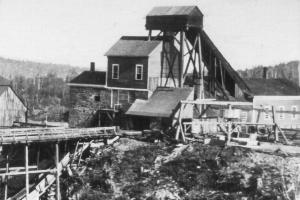 Canada
produced some shale oil from deposits in New Brunswick in the
mid-1800's. The mineral was called
Albertite and was originally believed to be a form of coal. Canada
produced some shale oil from deposits in New Brunswick in the
mid-1800's. The mineral was called
Albertite and was originally believed to be a form of coal.
 Albert Mine, near Moncton, New Brunswick,
c. 1850's Albert Mine, near Moncton, New Brunswick,
c. 1850's
Later, the nature of
the mineral and its relation to the surrounding oil shale was
described correctly. Abraham Gesner used Albertite in his early
experiments to distill liquid fuel from coal and solid bitumen.
He is credited with the invention of kerosene in 1846, and built
a significant commercial distillery to provide lighting oil to
replace whale oil in eastern Canada and USA. In the 1880's,
shale oil was abandoned as a source of kerosene in favour of
distillation from liquid petroleum.
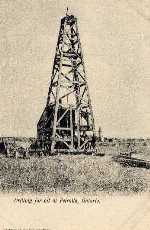 The
subsequent development of Canada's first petroleum complex at
Petrolia in Ontario is a little known part of the industrial saga of the
oil industry. Canada's chemical valley in Sarnia traces its ancestry
directly to this area. During the period 1861 to 1897, nearly
the entire requirement of Canada for crude, lubricants, waxes,
kerosene, gasoline, and a widening range of chemicals for food,
medicine, and industry was produced here. From 1863 to 1870, Canada
was a major exporter of crude and refined products to the United
States and Europe. The
subsequent development of Canada's first petroleum complex at
Petrolia in Ontario is a little known part of the industrial saga of the
oil industry. Canada's chemical valley in Sarnia traces its ancestry
directly to this area. During the period 1861 to 1897, nearly
the entire requirement of Canada for crude, lubricants, waxes,
kerosene, gasoline, and a widening range of chemicals for food,
medicine, and industry was produced here. From 1863 to 1870, Canada
was a major exporter of crude and refined products to the United
States and Europe.
Early
oil well at Petrolia, Ontario, Canada c. 1860's 
The
contribution that Canadians made to the world's petroleum industry
during the same period is even less appreciated. Men trained in
the production, transportation, refining, and administration of
this new resource, took their knowledge and skills to every corner
of the world, opening many of the great oil fields that are still
major suppliers of crude. They laboured on every continent in
a hundred different countries. And the tradition continues to
this day.
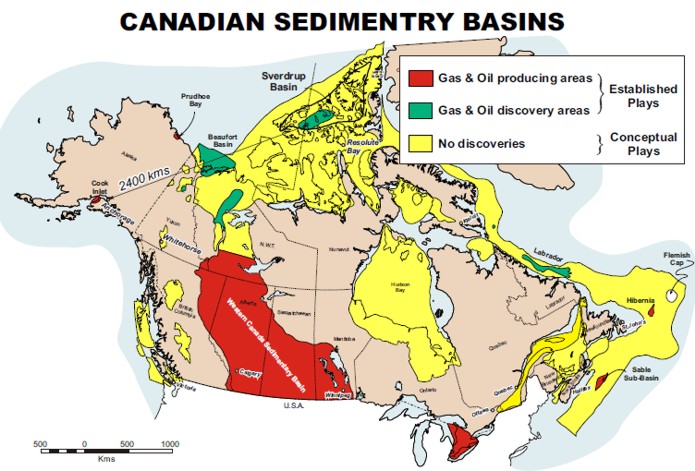
Map of Canada, showing main producing basins, discovered but
undeveloped basins, and prospective sedimentary areas.
New
Brunswick achieved commercial production at Stoney Creek in 1884,
although it was pretty minor by early Ontario standards, and these
wells continued in production until modern times. Quebec, Prince
Edward Island, onshore Nova Scotia, and onshore Newfoundland never
found commercial quantities of oil or gas.
The
first gas well in Alberta was drilled in 1883 at Alderson (then
known as Langevin Siding), near Medicine Hat, by the Canadian
Pacific Railway. They were, of course, looking for water. This
well struck gas, caught fire, burned down the rig injuring one
man who had to jump off, and was abandoned. A second well, the
following year, again struck gas (it was only 8 feet away from
the first one) and produced off-and-on for about 40 years. These,
and similar wells, came to the notice of the Canadian government.
Dr.
George Dawson of the Geological Survey of Canada, collected information
on the wells at Langevin Siding and others, and presented a paper
to the Royal Society of Canada in May, 1886. The paper was called
"On Certain Borings in Manitoba and the Northwest Territory".
The paper contained detailed sample descriptions of the wells
- possibly the first "well logs" in Western Canada.
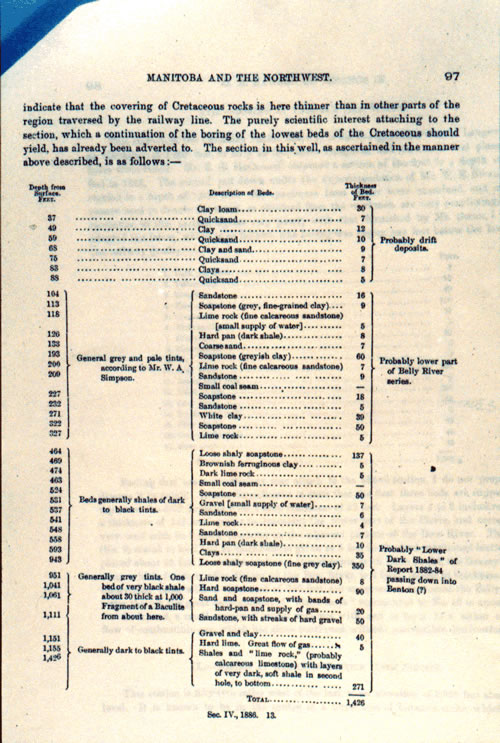
One of the first well logs in Western Canada
from Proceedings and Transactions of the Royal
Society of Canada
for the Year 1886 Volume IV.
Glenbow Archives
By
the early 1890s several more wells had been drilled in the Medicine
Hat area, producing gas for homes and factories. Rudyard Kipling,
on a visit in the early 1900’s, admitted that he liked Medicine
Hat but "It has all hell for a basement!"
 By
1908, development of the Bow Island gas field led to the first
pipelines to deliver natural gas to Alberta communities. Construction
of a 16-inch pipeline from southwest of Medicine Hat to Calgary
began in April 1912 and was completed in only 86 days. A second
leg reached Lethbridge in July 1908. This was spearheaded
by Eugene Coste, Canada's first natural gas engineer. He had discovered
the first commercial gas well in Essex County Ontario in 1888. By
1908, development of the Bow Island gas field led to the first
pipelines to deliver natural gas to Alberta communities. Construction
of a 16-inch pipeline from southwest of Medicine Hat to Calgary
began in April 1912 and was completed in only 86 days. A second
leg reached Lethbridge in July 1908. This was spearheaded
by Eugene Coste, Canada's first natural gas engineer. He had discovered
the first commercial gas well in Essex County Ontario in 1888.
 Eugene Coste Eugene Coste
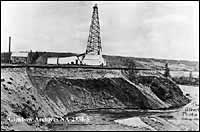 The
Alberta oil boom didn't begin until 1914 with the drilling of
Dingman #1 near Turner Valley. A replica of the drilling rig lives
at Heritage Park in Calgary. This wet gas success started a stock
market flurry that died less than a year later with the loss of
most of the investors' money. The
Alberta oil boom didn't begin until 1914 with the drilling of
Dingman #1 near Turner Valley. A replica of the drilling rig lives
at Heritage Park in Calgary. This wet gas success started a stock
market flurry that died less than a year later with the loss of
most of the investors' money.
Dingman #1,
Turner Valley, Alberta, Canada, 1914 
The
well was the precursor for the deeper zone discovery drilled ten
years later. Royalite #4 put Turner Valley on the oil and gas
map for real.
 In
1919, Imperial Oil geologist Ted Link, a crew of six drillers
and an ox named "Nig" made a six-week, 1200 mile journey
northward by railway, river boat, and on foot to the site now
known as Norman Wells NWT, along the Mackenzie River. The ox helped
to build a log house and put the drilling rig in place before
being butchered to provide food for the winter. Drilling resumed
in the spring with the world's most northerly oil discovery coming
in August 1920. In
1919, Imperial Oil geologist Ted Link, a crew of six drillers
and an ox named "Nig" made a six-week, 1200 mile journey
northward by railway, river boat, and on foot to the site now
known as Norman Wells NWT, along the Mackenzie River. The ox helped
to build a log house and put the drilling rig in place before
being butchered to provide food for the winter. Drilling resumed
in the spring with the world's most northerly oil discovery coming
in August 1920.
 Ted Link
Ted Link
  Between
1920 and 1947, there were a dozen or so significant oil discoveries
in the Cretaceous of Alberta, but no "elephants", and
nothing very deep. Vern Hunter drilled Imperial Oil's Leduc #1
Devonian oil discovery in 1947, ending a long dry spell in the
Alberta search. Between
1920 and 1947, there were a dozen or so significant oil discoveries
in the Cretaceous of Alberta, but no "elephants", and
nothing very deep. Vern Hunter drilled Imperial Oil's Leduc #1
Devonian oil discovery in 1947, ending a long dry spell in the
Alberta search.
Vern Hunter,
and Leduc #1
blowout, Leduc, Alberta, Canad, 1947 
Although minor shows were found much earlier,
1951 saw the first commercial oil discoveries in Manitoba and
British Columbia, followed by Saskatchewan ln 1953. Over the next
20 years, Canada became self sufficient in oil and gas.
 As
early as 1921, Dr. Karl Clark pioneered the extraction of oil
from tar sands by the hot water process. He built pilot plants
in 1930 at Clearwater, Alberta and in 1949 at Bitumont under the auspices
of the Alberta Research Council. Great Canadian Oil Sands Ltd
(later Suncor) began production of the Athabasca tar sands north
of Fort McMurray in 1967. As
early as 1921, Dr. Karl Clark pioneered the extraction of oil
from tar sands by the hot water process. He built pilot plants
in 1930 at Clearwater, Alberta and in 1949 at Bitumont under the auspices
of the Alberta Research Council. Great Canadian Oil Sands Ltd
(later Suncor) began production of the Athabasca tar sands north
of Fort McMurray in 1967.
 Dr Karl Clark
Dr Karl Clark
Shell drilled offshore British Columbia
that year, but found nothing. A few years later, the BC Government
placed a moratorium on further drilling that has not been lifted.
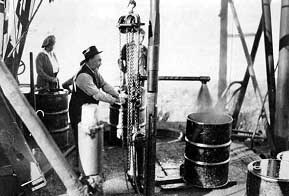
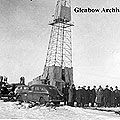

Norman Wells 1922
Leduc 1947
Winter Harbour 1961
On
the other frontiers, hydrocarbons were found offshore Nova Scotia
(gas at Sable Island, 1967, oil at Cohasset, 1973), offshore Newfoundland
(oil at Terra Nova, 1984), offshore in the Beaufort Sea and MacKenzie
Delta (gas at Taglu, 1971, oil at Amauligak, 1978), onshore and
offshore in the High Arctic Islands (gas at Drake Point, 1969
- oil at Bent Horn, 1974). It took between 20 and 30 years for
some of these to come on-stream, and Arctic gas is still shut-in.
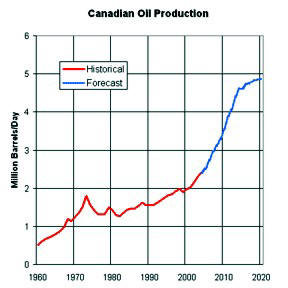 Canada's
conventional oil production peaked in 1974, but tar sands production
has replaced the decline. Current capacity in the
tar sands has brought Canadian production to more than 2 million
barrels per day, with a target of 5 million by the year 2020 (equal
to Iraq or Iran, and double Venezuela). Canada's
conventional oil production peaked in 1974, but tar sands production
has replaced the decline. Current capacity in the
tar sands has brought Canadian production to more than 2 million
barrels per day, with a target of 5 million by the year 2020 (equal
to Iraq or Iran, and double Venezuela).
Canada's steady increase in production contrasts markedly with
production declines in nearly every other oil-producing country.
The
majority of Canadian production is exported to the United States by
pipeline. Canada is the largest single supplier of US oil needs, a
fact not well appreciated by US citizens or the rest of the world.
Aside
from the tar sands, another significant reason for increased
production is that small independent oil companies, operating under
a favourable free-enterprise tax system and rule of law, are content
to produce from thin, low productivity, low quality reservoirs. The
risk of political upheaval or confiscation is very low.
Policies, politics, and egos (not economics) make production from
poor quality reservoirs difficult in most other regimes, except in
the continental US and Western Europe on-shore. There is no magic
bullet to cure the world's addiction to oil, so the exploitation of
lower quality reservoirs will have to become "standard operating
practice" very soon in the rest of the world.
|

